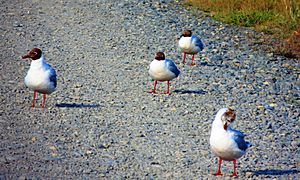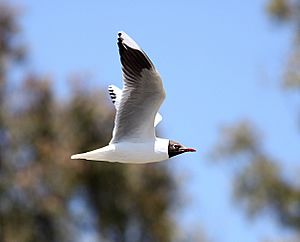Brown-hooded gull facts for kids
Quick facts for kids Brown-hooded gull |
|
|---|---|
 |
|
| Conservation status | |
| Scientific classification | |
| Genus: |
Chroicocephalus
|
| Species: |
maculipennis
|
| Synonyms | |
|
Larus maculipennis |
|
The brown-hooded gull (Chroicocephalus maculipennis) is a type of gull that lives in South America. You can find it in countries like Argentina, Brazil, Chile, the Falkland Islands, and Uruguay. Its scientific name, maculipennis, means 'spotted wings'. This bird is mostly white, but it has a brown head, a red beak, and red feet.
What Does It Look Like?
Adult brown-hooded gulls have a dark brown head and throat. They have a white half-circle shape behind their eyes. Their neck, chest, and belly are white. Their beak and legs are bright red.
The main flight feathers on their wings are dark gray. Other feathers on their wings are a lighter gray. Sometimes, people might confuse this gull with the Franklin's gull. Male and female brown-hooded gulls look very similar.
Where Do They Live?
These gulls live in South America. They breed in places like Argentine and Chilean Patagonia, the Falkland Islands, and Uruguay. When winter comes, they fly north to the coasts of northern Chile and central Brazil.
You can find them in many different places. They like freshwater lakes, marshy areas near the ocean, river banks, and open fields.
How Do They Live?

Brown-hooded gulls are very social birds. They often live and fly in groups. Their main food is insects. They also eat dead animals, called carrion.
Sometimes, they steal food from other birds. This is called kleptoparasitism. For example, they often steal crabs from the red-gartered coot. They also take clams from the American oystercatcher. It's much easier for them to steal from the coots than from the oystercatchers.
These gulls build their nests on water. They use plants found in ponds and lakes to make floating nests. Usually, a female gull will lay three or four eggs in her nest.
Interestingly, the black-headed duck sometimes lays its eggs in the nests of brown-hooded gulls. This is called brood parasitism. The black-headed duck wants the gull to hatch and raise its ducklings instead of doing it herself!
See also
 In Spanish: Gaviota capucho café para niños
In Spanish: Gaviota capucho café para niños




